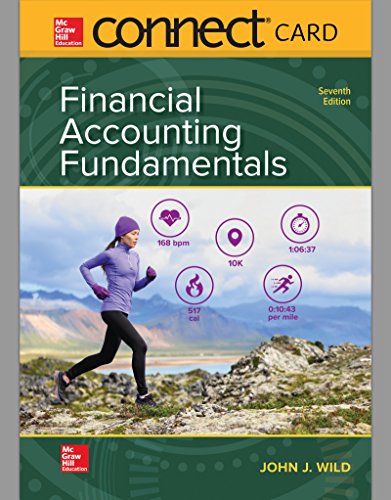
Prepare the
Explanation of Solution
Prepare the journal entry to record issuance of notes as follows:
| Date | Account titles and Explanation | Debit | Credit |
|
January 1, 2017 | Cash | $100,000 | |
| Notes payable | $100,000 | ||
| (To record issuance of notes payable) |
Table (1)
- Cash is a current asset, and it is increased. Therefore, debit cash account for $100,000.
- Notes payable is a short term liability, and it is increased. Therefore, credit notes payable account for $100,000.
Journalize the first note payment on December 31, 2017, as follows:
| Date | Account Title and Explanation |
Post Ref. |
Debit ($) |
Credit ($) |
| December 31, 2017 | Notes Payable | 22,523 (2) | ||
| Interest Expense | 7,000 (1) | |||
| Cash | 29,523 | |||
| (To record the first payment of bonds payable with due interest) |
Table (2)
Working Notes:
Interest expense for one year is computed as below:
Calculate the portion of notes payable paid.
Interest expense = $7,000
Four equal payments = $29,523
- Notes Payable is a liability and decreased, so debit it for $22,523.
- Interest expense is a component of
stockholders’ equity and decreased it, so debit interest expense for $7,000. - Cash is an asset and decreased, so credit it for $29,523
Journalize the second note payment on December 31, 2018, as follows:
| Date | Account Title and Explanation |
Post Ref. |
Debit ($) |
Credit ($) |
| December 31, 2018 | Notes Payable | 24,100 (4) | ||
| Interest Expense | 5,423 (3) | |||
| Cash | 29,523 | |||
| (To record the second payment of bonds payable with due interest) |
Table (3)
Working Notes:
Interest expense for second year is computed as below:
Calculate the portion of notes payable paid.
Interest expense = $5,423
Four equal payments = $29,523
- Notes Payable is a liability and decreased, so debit it for $24,100.
- Interest expense is a component of stockholders’ equity and decreased it, so debit interest expense for $5,423.
- Cash is an asset and decreased, so credit it for $29,523
Journalize the third note payment on December 31, 2019, as follows:
| Date | Account Title and Explanation |
Post Ref. |
Debit ($) |
Credit ($) |
| December 31, 2019 | Notes Payable | 25,787 (6) | ||
| Interest Expense | 3,736 (5) | |||
| Cash | 29,523 | |||
| (To record the third payment of bonds payable with due interest) |
Table (4)
Working Notes:
Interest expense for third year is computed as below:
Calculate the portion of notes payable paid.
Interest expense = $3,736
Four equal payments = $29,523
- Notes Payable is a liability and decreased, so debit it for $25,787.
- Interest expense is a component of stockholders’ equity and decreased it, so debit interest expense for $3,736.
- Cash is an asset and decreased, so credit it for $29,523
Journalize the fourth note payment on December 31, 2020, as follows:
| Date | Account Title and Explanation |
Post Ref. |
Debit ($) |
Credit ($) |
| December 31, 2020 | Notes Payable | 27,590 (8) | ||
| Interest Expense | 1,933 (7) | |||
| Cash | 29,523 | |||
| (To record the fourth payment of bonds payable with due interest) |
Table (5)
Working Notes:
Interest expense for fourth year is computed as below:
Calculate the portion of notes payable paid.
Interest expense = $1,933
Four equal payments = $29,523
- Notes Payable is a liability and decreased, so debit it for $27,590.
- Interest expense is a component of stockholders’ equity and decreased it, so debit interest expense for $1,933.
- Cash is an asset and decreased, so credit it for $29,523
Want to see more full solutions like this?
Chapter 10 Solutions
Connect Access Card For Financial Accounting Fundamentals
- Can you help me solve this accounting problem with the correct methodology?arrow_forwardHow can I solve this financial accounting problem using the appropriate financial process?arrow_forwardDavis Company reported an increase of $350,000 in its accounts receivable during the year 2023. The company's statement of cash flows for 2023 reported $980,000 of cash received from customers. What amount of net sales must Davis have recorded in 2023?arrow_forward
- Roosevelt Equipment Ltd. manufactures industrial cranes. The standard for a specific crane model calls for 30 direct labor hours at $22 per direct labor hour. During a recent period, 400 cranes were produced. The labor rate variance was zero, and the labor efficiency variance was $8,800 unfavorable. How many actual direct labor hours were worked?arrow_forwardNolan Industries assigns overhead costs to jobs on the basis of 140% of direct labor costs. The job cost sheet for Job 627 includes $31,200 in direct materials cost and $18,500 in direct labor cost. A total of 2,500 units were produced in Job 627. Required: a. What is the total manufacturing cost assigned to Job 627? b. What is the unit product cost for Job 627?arrow_forwardCarlisle Services reported revenues of $78,000, expenses of $72,500, and dividends of $5,800 for the month ended February 28, 2024. Carlisle Services experienced a net income or net loss of what amount?arrow_forward

 AccountingAccountingISBN:9781337272094Author:WARREN, Carl S., Reeve, James M., Duchac, Jonathan E.Publisher:Cengage Learning,
AccountingAccountingISBN:9781337272094Author:WARREN, Carl S., Reeve, James M., Duchac, Jonathan E.Publisher:Cengage Learning, Accounting Information SystemsAccountingISBN:9781337619202Author:Hall, James A.Publisher:Cengage Learning,
Accounting Information SystemsAccountingISBN:9781337619202Author:Hall, James A.Publisher:Cengage Learning, Horngren's Cost Accounting: A Managerial Emphasis...AccountingISBN:9780134475585Author:Srikant M. Datar, Madhav V. RajanPublisher:PEARSON
Horngren's Cost Accounting: A Managerial Emphasis...AccountingISBN:9780134475585Author:Srikant M. Datar, Madhav V. RajanPublisher:PEARSON Intermediate AccountingAccountingISBN:9781259722660Author:J. David Spiceland, Mark W. Nelson, Wayne M ThomasPublisher:McGraw-Hill Education
Intermediate AccountingAccountingISBN:9781259722660Author:J. David Spiceland, Mark W. Nelson, Wayne M ThomasPublisher:McGraw-Hill Education Financial and Managerial AccountingAccountingISBN:9781259726705Author:John J Wild, Ken W. Shaw, Barbara Chiappetta Fundamental Accounting PrinciplesPublisher:McGraw-Hill Education
Financial and Managerial AccountingAccountingISBN:9781259726705Author:John J Wild, Ken W. Shaw, Barbara Chiappetta Fundamental Accounting PrinciplesPublisher:McGraw-Hill Education





